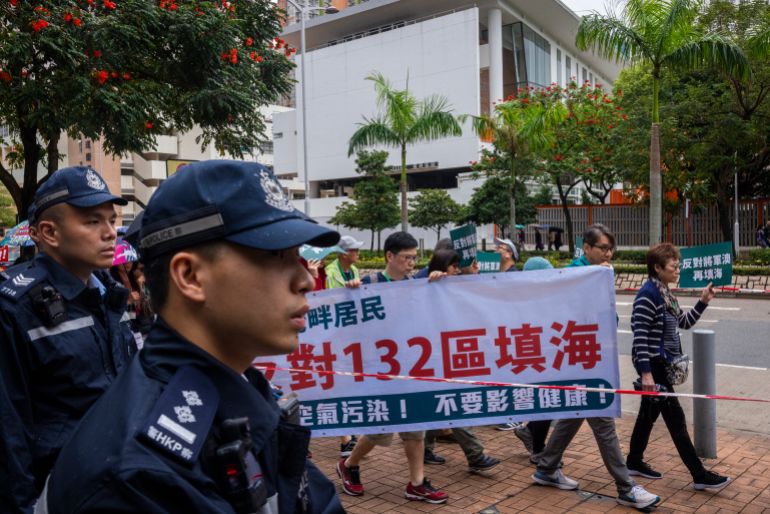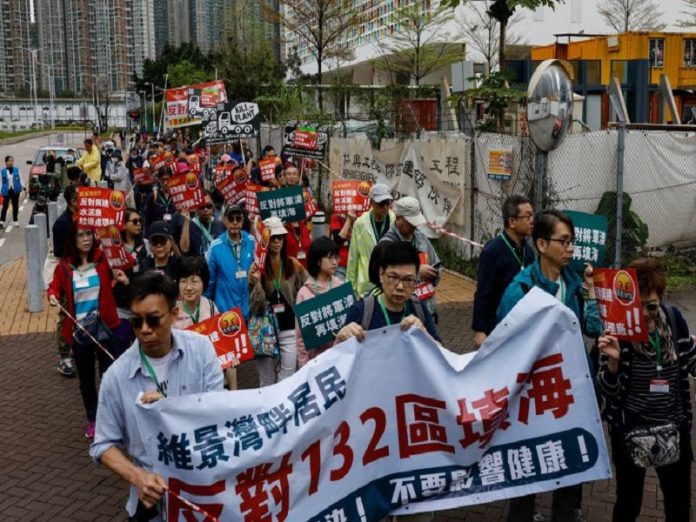Several dozen demonstrators on Sunday were required to wear numbered lanyards and were barred from wearing masks, as police monitored their march against a proposed land reclamation and rubbish processing project.
Participants chanted slogans against the reclamation project as they marched in the rain with banners in the eastern district of Tseung Kwan O, where the project is slated to be built.
Some criticised the restrictions on their protest, which included limiting the number of participants to 100, according to a seven-page letter from the police to organisers, seen by Reuters.
“We need to have a more free-spirited protest culture,” said James Ockenden, 49, who was marching with his three children.
“But this is all pre-arranged and numbered and it just destroys the culture and will put people off from coming for sure.”
Responding to the protest, the city’s Development Bureau said the project was intended to “support the daily needs of the community”.
It said it would “respect the right to freedom of expression” and would study the possibility of reducing the scale of the land reclamation.
Police granted the organisers a “no objection” letter on the condition that they ensured the protest would not violate national security laws, including seditious displays or speech.
“Some lawbreakers may mix into the public meeting and procession to disrupt public order or even engage in illegal violence,” the police warned in their letter.

Applications for other protests, including a candlelit vigil on June 4 to commemorate the victims of China’s Tiananmen Square crackdown in 1989, have been denied on grounds related to COVID social distancing.
The last of Hong Kong’s COVID restrictions was scrapped this year, following China’s decision to end its “zero-COVID” policies.
Hong Kong’s mini-constitution, the Basic Law, guarantees the right to public assembly.
Since the China-imposed national security law, enacted in June 2020 in response to protracted pro-democracy protests in 2019, authorities have clamped down on freedoms and arrested scores of opposition politicians and activists.
Some Western governments have criticised the law as a tool of repression but Chinese authorities say it has restored stability to the financial hub.
One protester surnamed Chiu, 50, said she appreciated the chance to protest “in difficult times”, and said she saw the lanyards more as a means to facilitate crowd management.
“It doesn’t mean putting a leash on us to restrict our expression. I think it’s acceptable,” she told Reuters.
READ ALSO: Chinese military says US ship ‘warned’ away in South China Sea
Political observers and some Western diplomats are watching to see if authorities will allow a resumption of major demonstrations in Hong Kong, namely on June 4 and July 1, which had been a mainstay of the city’s once vibrant civil society scene and attracted thousands of people.
Earlier this month, the Hong Kong Women Workers’ Association planned a march to call for labour and women’s rights but cancelled it at the last moment without specifying why.
Days later, the association said on its Facebook page that the police had invited it for further meetings after granting it the approval and that it had tried its best to amend the agreement. But it still could not launch the protest as it had wished, it wrote at that time.
A pro-democracy group separately said national security police had warned four of its members not to participate in the association’s march.

